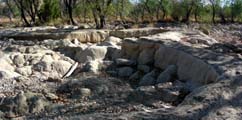
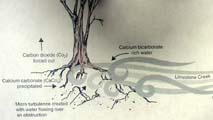
Time has slowly created the natural dam walls.
The walls are formed by a combination of limestone deposition and
algae growth, which created a by-product known as tufa.
Tufa forms when fresh spring or stream water saturated in calcium
carbonate, such as the water in Limestone Creek, flows over the
lip of cascades and around obstructions.
The rapid movement of water creates a turbulence which forces carbon
dioxide out of the water resulting in a chemical reaction which
causes the release of solid calcium carbonate from the water.
This calcium carbonate (or calcite) builds up on any solid object
such as a tree root or rock.
Over time layer upon layer of sediment is deposited, thus creating
the tufa.
During the wet season, when the water flow is at its greatest,
the calcite flow may become a different colour.
Algae and other small organisms which grow on the tufa walls trap
and cover particles of calcite.
When these small organisms die they leave the white porous calcium
carbonate (or calcite) exposed.

The limestone tufa deposits of Limestone Gorge are a distinctive
geological feature, and an important source of information regarding
past and present processes acting on the landscape.
There are few places in the Northern Territory that give us such
accurate information about the climate of the past.
This is one of the reasons that preserving the calcite formations
is of such importance to scientists.
Both ancient "relic" and "modern" tufa are
found here in Limestone Creek.
Radio carbon dating shows the "relic" tufas were active
in the early Holocene period up to 10'000 years ago.
Due to the intense monsoonal climate "relic" tufa growth
was vigorous, estimated at around 0.5 mm per year.
This wet phase was followed by an arid phase when deposition ceased.
Conditions once again became favourable for tufa growth at around
1'600 years ago when "modern" tufas began to develop.
The growth rate of these modern tufas is very slow, approximately
0.2 mm per year.
The tufa dams are quite fragile as the brittle limestone is easily
damaged.
Recent studies of Limestone Creek during the wet season shows
a average pH of 8 and water temperature of 28°C, giving scientists
further information about the creation of these unique geological
formations.
The alkalinity of the water in this creek affects both the soil
and the type of plants that grow along the creek.
Plants that grow near these tufa formations are particularly tolerant
of alkaline soil.
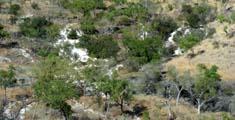

The white formation in the creek bed known as "The White
Waterfalls" is a calcite flow too.
These flows form when calcium carbonate rich water flows vigorously
down a slope.
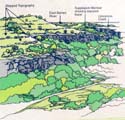
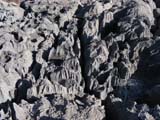
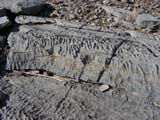
Limestone Gorge cuts through the Skull Creek Formation and the
Supplejack Dolomite Member of the Bullita group.
These rocks are primarily composed of the mineral dolomite, a type
of limestone.
The limestones formed in a shallow lagoon environment in the Adelaidean
period, approx. 1'200 to 550 million years ago.
In Limestone Gorge the Supplejack Dolomite is overlain by the
Skull Creek Formation.
Where the Skull Creek Formation is stripped away by erosion some
distinctive landforms quickly develop in the Supplejack Dolomite.
The karst, grey in colour, forms where the overlaying layer has
been stripped away, exposing the stromatolitic dolomite beneath.
The heavy rains of the wet season wash away the softer minerals
causing the dolomite to become deeply pitted.
The jagged outcrops of this corroded dolomite are known as karst.
The high, sharp limestone pinnacles are an excellent example of
a well developed tropical karst landscape.
The sharp limestone in this area is known as "Rillenkarren".
It has been created by a form of acid rain.
Carbon dioxide from the atmosphere is absorbed by the rain bearing
clouds.
The rain from these clouds is a weak carbonic solution which dissolves
the softer parts of the limestone, creating the sharp, rippled
effect.
The Aboriginal people discovered a process to make the limestone
rock easier to split, giving the rock sharp edges.
A section of the rillenkarren is heated in a fire, then it is cooled
very quickly by immersing the rock in cool water.
Aboriginal people then use the sharp rock to make tools such as
spear heads, knife edges and stone axes.
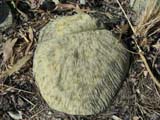

Stromatolites, considered to be amongst the oldest evidence of
life on earth, can be seen here.
They occur today but are not as prolific as they were during the
Adelaidean period.
Stromatolites are formed in shallow seas and lagoons when millions
of cyanobacteria (primitive bacterial life forms) colonise together
in a "cabbage shaped" growth.
Filaments, protruding from the cyanobacteria, trap sediments.
These may eventually become fossilised, thus creating stromatolites.
The Skull Creek formation at Limestone Gorge contains an abundance
of exceptionally well preserved stromatolites.
Geologists describe this high density of stromatolitic formations
as "reefs".
They are typically around one metre in diameter but much larger
examples can be seen.
From the lookout a series of unusually large stromatolites are
evident, some of these are in excess of 20 metres in diameter.
Some stromatolites show ripple marks, which were formed by waves
passing across them tens of millions of year ago, in the same way
that ripple marks form on tidal flats today.
Alive stromatolites can be found at Hamelin Pool, near Shark Bay
(WA).
Click
here for more details on those stromatolites.
|









